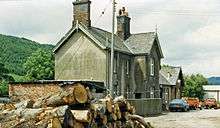Mold and Denbigh Junction Railway
| Mold & Denbigh Jn Rly | ||||||||||||||||||||||||||||||||||||||||||||||||||||||||||||||
|---|---|---|---|---|---|---|---|---|---|---|---|---|---|---|---|---|---|---|---|---|---|---|---|---|---|---|---|---|---|---|---|---|---|---|---|---|---|---|---|---|---|---|---|---|---|---|---|---|---|---|---|---|---|---|---|---|---|---|---|---|---|---|
Legend | ||||||||||||||||||||||||||||||||||||||||||||||||||||||||||||||
| ||||||||||||||||||||||||||||||||||||||||||||||||||||||||||||||
The Mold and Denbigh Junction Railway was a 15 3⁄4-mile (25.3 km) link railway in North Wales, between the Mold Railway and the Vale of Clwyd Railway. It was incorporated on 6 August 1861 and closed to passengers in 1962.
History
The Mold and Denbigh Junction Railway company was incorporated on the 6 August 1861 to build a 15.75-mile (25.35 km) link railway between the Mold Railway and the Vale of Clwyd Railway.[1] The line opened on 12 September 1869 and was worked by the London and North Western Railway (LNWR), although it remained independent.[1] Under the 1922 Railway grouping, the line became part of the London, Midland and Scottish Railway (LMS); and on nationalisation became part of British Railways.[1]
The line was formally closed throughout to passengers on 30 April 1962, (the last actual passenger trains had run on Saturday, 28 April) but goods and parcels traffic to Mold from Chester carried on. The track from Rhydymwyn to the junction with the Vale of Clwyd line, just north of Denbigh was lifted in 1963. However, limestone powder traffic continued to originate at Rhydymwyn and goods trains also served the Synthite chemical works just west of Mold. On 1 January 1968 the line was further reduced in operational length, terminating at the Synthite works. Access to Mold was now from Wrexham using an existing south to west junction with the national network at Penyffordd, on the former Great Central Wrexham to Bidston line; before it had continued under the GC line onwards to Broughton & Bretton and on to Mold Junction, west of Chester, where the line had joined the Chester & Holyhead main line. The Synthite to Rhydymwyn section, mothballed since 1968, was revived in 1974 for the transportation inwards of oil pipe sections for the Angelsey to Ellesmere Port pipe line, which uses part of the old M & D Jct trackbed near Afon Wen. Mold station survived until 1988 (though occupied by a builders merchant), and when the Synthite works transferred from rail to road haulage in March 1983 the line was subsequently lifted, having now lost its last remaining usage. Mold station was redeveloped as a Tesco supermarket but the original M & D Jct Rly station buildings at Rhydymwyn, Caerwys and Bodfari survive as private dwellings.

References
Notes
Sources
- Awdry, Christopher (1990). Encyclopaedia of British Railway Companies. Sparkford: Patrick Stephens Ltd. ISBN 1-8526-0049-7. OCLC 19514063.
- Butt, R. V. J. (1995). The Directory of Railway Stations: details every public and private passenger station, halt, platform and stopping place, past and present (1st ed.). Sparkford: Patrick Stephens Ltd. ISBN 1-8526-0508-1. OCLC 60251199.
- Dewick, Tony (2005). Britain's Railways: Rail Atlas 1890 (1st ed.). Hersham: Ian Allan Publishing Ltd. ISBN 0-7110-3031-6.
- Carvell, Roger (2009) The Chester to Denbigh Railway, ISBN 978-1-903266-47-2
External links
Coordinates: 53°12′49″N 3°14′40″W / 53.21361°N 3.24444°W